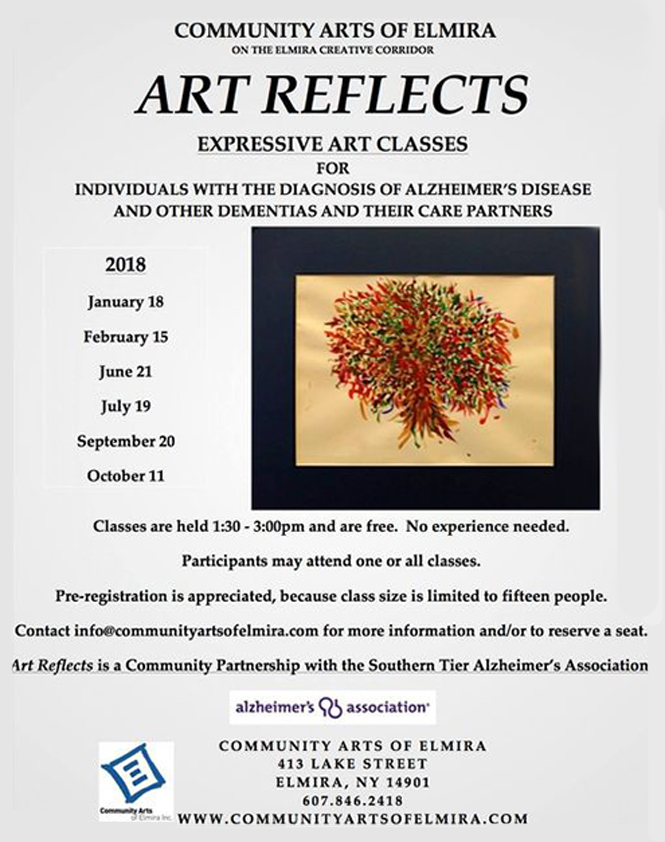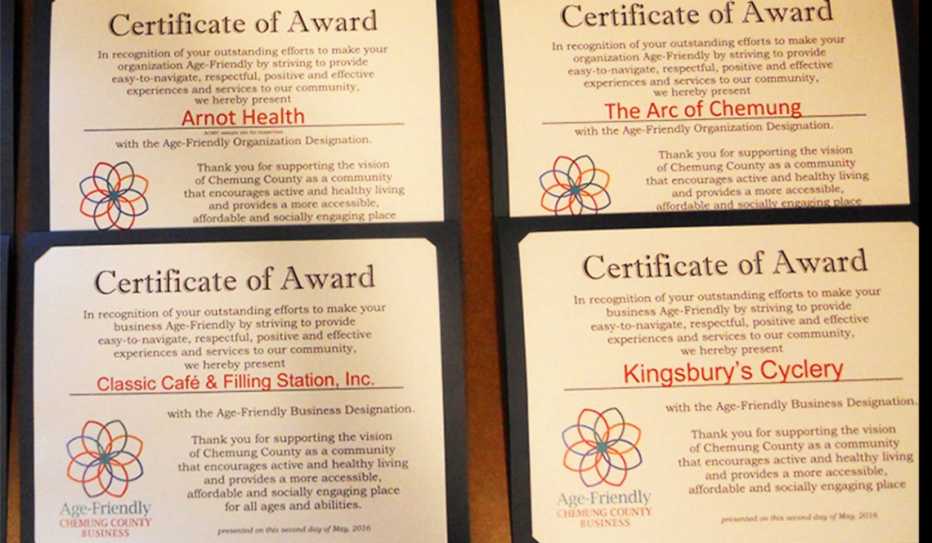AARP Hearing Center


ACTIVITIES AS OF FEBRUARY 2021
Member Profile
Chemung County, home to 83,000 people, is located in the southern gateway of the Finger Lakes Region in upstate New York. The over-65 population of this largely rural community has increased from 9 percent in 1940 to 16 percent in 2010 and is expected to reach 21 percent by 2030.
Initiative Name: Age-Friendly Chemung County
Network Member Since: Chemung County has been a member of the AARP Network of Age-Friendly States and Communities since 2012. The towns and cities within the county that also enrolled are Elmira (the city and town both joined in 2013), Big Flats (joining in 2014) and Southport (2015).
Government Type: Elected county executive and elected county legislature chair
Reason(s) for Joining: In 2010, Chemung County held a “community empowerment” planning meeting that helped to develop a coordinated network of community stakeholders, many of whom continue to be active coalition partners. Kim Salisbury, who directed the Chemung County Department of Aging and Long-Term Care until her retirement in early 2021, and Evanna C. Koska, a member of its advisory council, were very involved in the engagement efforts and subsequent age-friendly community initiative.
The Financials: Aside from a one-year grant, the financing and management of Chemung County’s age-friendly work has fallen to its Department of Aging and Long-Term Care. “We’ve managed well,” says Salisbury. “We are doing more with less and struggling with it, but in order for age-friendly work to survive here we need a paid facilitator. I think we’ve come as far as we can without any type of real structure.”
Actions and Achievements
Chemung County submitted its Action Plan in 2014 and an Action Plan Evaluation, or progress report, in 2018. “For a while I was thinking that we should be working on just one project,” says Salisbury. “But in reality, we were already working on so many applicable projects.” Following is a sampling of initiatives in the 8 Domains of Livability, focusing on the community features of Social Participation, Respect and Social Inclusion, and Communication and Information.


News and Notes
Chemung County is home to a popular initiative that began in the 1980s as a “marketplace of information and resources… and an effective voice for a strong and vital senior community.” After debuting as a radio show, The Senior Notebook moved to television in 1990. A new series called Aging Well focuses on the mental and physical benefits of social engagement.
Working ... Together
Kim Salisbury needs just one word to describe the age-friendly initiative’s biggest achievement: collaboration.
“It may sound simplistic, but it’s something I rely upon every day when I walk into this office,” she says. “We’ve brought together dedicated citizens, partners from government, community and interfaith organizations. These are partners that would otherwise never sit around the table together. I believe it’s the unique age-friendly collaborations that helped to identify the need for programs that encourage active and healthy living and engage people of all ages and abilities.”
Evanna C. Koska adds that “through the years we’ve had the opportunity to pull together people from different agencies and volunteers and look at the projects everyone was doing and then coordinate. Because people learned what others were doing, such as enhancing the riverfront or parks, they were able to build on one another’s efforts and collaborate.”
Art and Alzheimer's
One collaboration that resulted is Art Reflects, a free, interactive, hands-on arts program for those with Alzheimer’s or other dementia conditions along with their care partners


The Power of Art
A flyer from Community Arts of Elmira promotes Art Reflects, a program for people with a diagnosis of Alzheimer's disease or other dementias and their care partners.
Lynne Rusinko is a co-founder of the program and president of the board of directors at Community Arts of Elmira. Karen Navaie "was essential to developing Art Reflects," Rusinko says, and is the program's art educator. Before the COVID-19 pandemic, Navaie and the Art Reflects' participants gathered several times a year to create works that were exhibited in Community Arts' Przygoda Gallery.
The inspiration for Art Reflects came about in 2016, when Marleah Denkenberger, then the program coordinator for the Southern Tier Alzheimer’s Association, "walked through our door," Rusinko recalls. "She said, ‘I’m interested in developing a program for individuals with the diagnosis of Alzheimer’s or dementia.’ I replied, ‘Community Arts is always open to collaboration and creative community partnerships, so let’s talk!'"
“The core element to the program is socialization," explains Rusinko. “Hands-on art projects encourage the participants’ self-expression and self-discovery.”
One remarkable voyage of self-discovery was taken by Cynthia Huling Hummel (pictured above), a Presbyterian pastor, who was diagnosed with mild cognitive impairment at 57 and Alzheimer’s four years later. After creating a single mask, along with other participants in a class offered through the program, she made 35 more in record time. The creations inspired her to self-publish a book called UnMasking Alzheimer’s: The Memories Behind the Masks. The masks, Hummel says, express the emotions she feels about having Alzheimer’s. She is a powerful advocate for Alzheimer’s research and speaks nationally about living with the disease.
For Rusinko, being involved with a program that “raises the awareness and understanding of those with dementia” has been deeply personal. She was a caregiver for both her parents before losing them both to dementia. “I felt my parents were shining a light for me — and still are,” she says. “Art Reflects has been a part of my own healing, and it’s part of my advocacy and my journey in helping others.”
Business Matters


Like other communities in AARP’s age-friendly network, Chemung County offers an age-friendly designation to businesses and organizations that adopt practices, and offer services and products suited to seniors.
The Turtle Leaf Café in Elmira has achieved Chemung County’s Age-Friendly Business and Organization Designation. “About a quarter of the people who dine with us are over 60 years old,” says owner Adam Bunce. “Some use walkers or wheelchairs. We wanted to make sure that whether someone is 5 or 95 there wouldn’t be any reason they couldn’t enjoy the restaurant. We’ve had customers thank us for having handrailings in the bathroom, adequate room to maneuver a wheelchair in there and that stairs aren’t needed to enter or exit the cafe.”
The age-friendly business designation has an added significance due to Chemung County’s economics. “Once businesses got the designation, they kind of got bragging rights to say, ‘Hey, you know what? I'm a bike shop, and I've got the age-friendly business designation,’” says Salisbury. “It was kind of a small marketing plan that could help, especially given the state of the economy in upstate New York. I think anything businesses and organizations can use to market what they're doing and do it in a positive light is a really sharp accomplishment.”
Lessons Learned (and Advice for Others)
"After years of making progress with age-friendly projects and initiatives, we finished our last evaluation and were settling down to develop our next steps. Then came COVID!" Evanna C. Koska, a member of the Chemung County Department of Aging and Long-Term Care advisory council, explains. "The pandemic has kept us from meeting in our normal way, but it also provides an opportunity for us to look around and think through where we should go in the future, with new and successful projects as our goal."
Kim Salisbury, the former department head, cites communications as one of the initiative's continuing goals.
“Whatever we do is always hit or miss,” she says. “For instance, we may have a program or service and we put time and energy into promoting it, yet people still say, ‘Gosh, I had no idea this program existed.’”
This challenge is noted in the county’s progress report, which includes the results of a community survey from 2013. “The primary finding was that our community has a wealth of services, opportunities and resources, but we need to do a better job of ensuring that residents are aware of and access the services that best meet their needs,” Salisbury says.
The limits of the county’s communication options hit a crisis level when the COVID-19 pandemic arrived.
“I have several employees in the rural areas of the county. They didn’t have reliable Wi-Fi service, so their cellphones and laptops weren’t working,” Salisbury explains, noting that public officials can’t simply rely on smartphones to get word out to community members, because many residents don’t use technology.
Another concern: The county's aging population is, says Salisbury, “expected to have fewer potential family caregivers, as these individuals are more likely to be divorced or never married and have fewer or no children. And those with children are likely to live farther away from their children than previous generations.”
Whatever the future brings, the work done by the initiative thus far has paved a path for success. “There’s an interconnectedness among us," says Salisbury. "We’ve reaped the benefits and rewards of the relationships we have developed. One of the greatest strengths of Age-Friendly Chemung is that we're a strong coalition and we're dedicated to ensuring that Chemung County is a community where people can live and age well."
Related Links
- Read about Age-Friendly Chemung County
- Visit AARP New York
- Learn about the AARP Network of Age-Friendly States and Communities
- Check out the network's Member List
- Find more Age-Friendly Member Impact and Achievement Profiles
Reporting by Amy Lennard Goehner































































